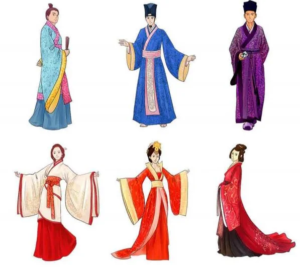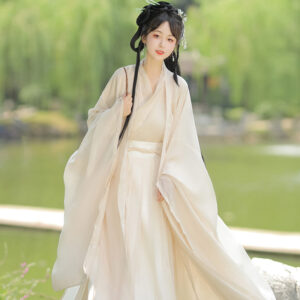

The differences between court and commoner Hanfu are profound, reflecting social status, cultural values, and the practical needs of daily life. Court Hanfu was luxurious, featuring silk and elaborate designs that symbolized status, while commoner Hanfu was simpler, made from practical materials like cotton or linen, reflecting everyday life.
| Aspect | Details |
|---|---|
| Court Hanfu | Luxurious fabrics, intricate designs, reserved for royalty and high-ranking officials. |
| Commoner Hanfu | Practical materials, simpler styles, designed for everyday wear by the general populace. |
| Symbolism | Court Hanfu colors and designs symbolize power and authority; commoner Hanfu reflects modesty. |
| Materials | Silk, brocade for court; cotton, linen for commoners. |
| Ornamentation | Richly adorned with gold/silver threads and precious stones in court; minimal decoration for commoners. |
Historical Context of Hanfu
Hanfu has deep historical roots in Chinese culture, dating back to the Han Dynasty (206 BC – 220 AD). The term “Hanfu” itself refers to the traditional clothing of the Han people and has evolved over centuries. During various dynasties, including the Tang and Song, the styles of Hanfu adapted to reflect changing cultural norms and social hierarchies.
Court Hanfu: A Symbol of Power
Court Hanfu represented not just fashion but also a visual language of power and authority. The attire was characterized by:
- Luxurious Fabrics: Primarily made from silk and brocade, court garments were often embellished with gold or silver threads. This opulence was a clear indicator of wealth and status.
- Complex Designs: Court Hanfu featured intricate embroidery with motifs that held significant meaning. For example, dragons symbolized imperial authority, while phoenixes represented grace.
- Color Significance: Colors like yellow were reserved exclusively for the emperor, symbolizing his central role in the universe. Other royals wore purple or red to denote their noble status.
- Layering: Court attire typically included multiple layers that added to its grandeur. The use of wide sleeves and flowing skirts enhanced the elegance of movement.
Commoner Hanfu: Practicality Over Opulence
In stark contrast to court attire, commoner Hanfu was designed with practicality in mind:
- Materials: Commoners primarily wore garments made from cotton or linen. These materials were affordable and durable, suitable for daily labor.
- Simplicity in Design: Commoner Hanfu featured simpler cuts with fewer layers. The focus was on functionality rather than elaborate ornamentation.
- Muted Colors: The colors of commoner clothing were generally subdued due to societal norms that reserved bright hues for the elite. This distinction helped maintain social order.
- Minimal Embellishments: While commoners might incorporate some embroidery, it was typically limited to basic patterns that reflected their everyday lives rather than complex symbolism.
Comparative Analysis: Style and Functionality
The differences between court and commoner Hanfu can be summarized in several key areas:
| Aspect | Court Hanfu | Commoner Hanfu |
|---|---|---|
| Fabric Quality | Fine silk and brocade | Coarse cotton or linen |
| Design Complexity | Intricate embroidery with multiple layers | Simple cuts with minimal decoration |
| Color Palette | Vibrant colors reserved for nobility | Muted tones reflecting practicality |
| Symbolism | Rich in cultural significance | Basic patterns without deep symbolism |
| Usage Context | Formal occasions and ceremonies | Everyday wear for laborers |
Social Implications of Dress
The distinctions between court and commoner Hanfu were not merely aesthetic but also deeply rooted in social implications:
- Status Representation: Court attire served as a clear marker of social hierarchy. Those adorned in luxurious fabrics were immediately recognized as members of the elite class.
- Cultural Norms: The differences in dress reflected broader cultural norms regarding class structure in ancient China. Clothing became a means of reinforcing societal roles.
- Economic Factors: The availability of materials played a significant role in determining what individuals could wear. Wealthier families had access to fine silks while commoners relied on more affordable fabrics.
Evolution Over Time
As Chinese society evolved through different dynasties, so too did the styles of Hanfu:
- Tang Dynasty Influence: The Tang Dynasty saw an increase in cultural exchange along trade routes like the Silk Road. This led to more diverse styles being incorporated into both court and commoner attire.
- Song Dynasty Simplification: By the Song Dynasty (960–1279 AD), there was a trend towards more practical clothing for both classes due to economic shifts and changing lifestyles.
Modern Interpretations
Today, there has been a resurgence of interest in traditional Chinese clothing among younger generations:
- Cultural Revival: Many young people are embracing Hanfu as a way to connect with their heritage. This revival includes both court-inspired designs for formal occasions as well as simplified versions suitable for everyday wear.
- Fashion Fusion: Modern interpretations often blend traditional elements with contemporary fashion trends, making Hanfu accessible to a wider audience while still honoring its rich history.
Conclusion: A Reflection of Society
The differences between court and commoner Hanfu serve as a fascinating reflection of ancient Chinese society’s values, hierarchies, and cultural practices. Through their attire, individuals communicated not only their social status but also their identity within a complex social fabric that defined life during those times.
Share this post
Recent Posts


What were the key features of Hanfu during the Tang Dynasty?

How did Hanfu styles vary during different Chinese dynasties?

What accessories are typically worn with Hanfu?

How do you choose the right Hanfu for different seasons?

Newsletter
Popular Categories
Related Post
Sed aliquam, tortor et sodales malesuada, lorem leo luctus tellus, quis interdum eros nibh in nunc. Cras dignissim malesuada, lorem leo luctus

What are the winter hanfu called?

What were the key features of Hanfu during the Tang Dynasty?

How did Hanfu styles vary during different Chinese dynasties?


